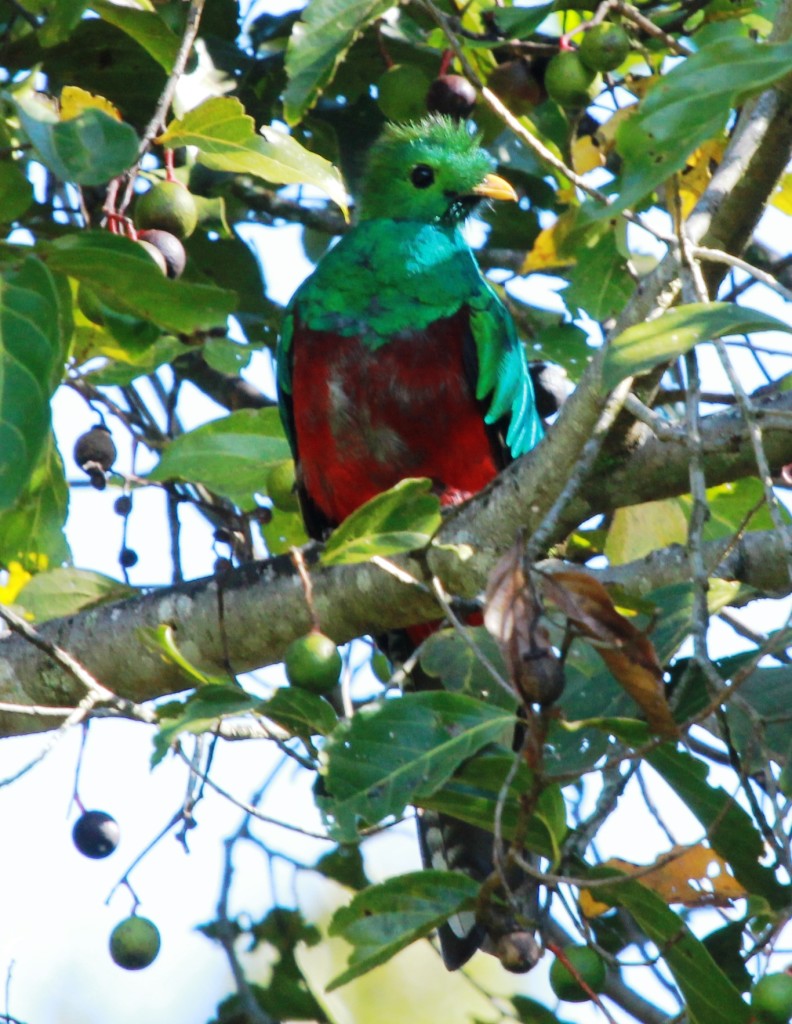All birds are beautiful in one way or another but the Resplendent Quetzal (Pharomachrus mocinno) is spectacularly gorgeous! They look like little gods come down to earth and when you see one, you will wonder if you should be worshiping it or photographing it.
 The Resplendent Quetzal (Pharomachrus mocinno) is a bird in the trogon family. It is found from southern Mexico to western Panama (unlike the other quetzals of the genus Pharomachrus, which are found in South America and eastern Panama). It is well known for its colorful plumage. There are two subspecies, P. m. mocinno and P. m. costaricensis.
The Resplendent Quetzal (Pharomachrus mocinno) is a bird in the trogon family. It is found from southern Mexico to western Panama (unlike the other quetzals of the genus Pharomachrus, which are found in South America and eastern Panama). It is well known for its colorful plumage. There are two subspecies, P. m. mocinno and P. m. costaricensis.
This quetzal plays an important role in Mesoamerican mythologies. The Resplendent Quetzal is Guatemala’s national bird, and an image of it is on the flag and coat of arms of Guatemala. It is also the name of the local currency (abbreviation GTQ).
In ancient Mayan culture, the quetzal bird’s tail feathers were used as currency. The Resplendent Quetzal was considered divine, associated with the “snake god”, Quetzalcoatl by Pre-Columbian Mesoamerican civilizations. Its iridescent green tail feathers, symbols for spring plant growth, were venerated by the ancient Aztecs and Maya, who viewed the quetzal as the “god of the air” and as a symbol of goodness and light. Mesoamerican rulers and some nobility of other ranks wore headdresses made from quetzal feathers, symbolically connecting them to Quetzalcoatl. Since it was a crime to kill a quetzal, the bird was simply captured, its long tail feathers plucked, and was set free. Quetzalcoatl was the creator god and god of wind, often depicted with grey hair. In several Mesoamerican languages, the term for quetzal can also mean precious, sacred, or erected.
WHERE TO SEE THEM IN THE WILD
Their habitat is montane cloud forest from Southern Mexico to Panama. I was lucky enough to see them in 2 locations in Costa Rica – Monteverde & Savegre/San Gerardo de Dota. Use your airline miles to get to Central America, then use shuttles or public transport to get to these locations.
Red dots are Monteverde & Savegre in Costa Rica
Mature male with fully grown tail feathers
.
Females are less spectacular but still beautiful.
INTERESTING LEGENDS OF RESPLENDENT QUETZALS
From Wikipedia:
Until recently, it was thought that the Resplendent Quetzal could not be bred or held for any long time in captivity, and indeed it was noted for usually killing itself soon after being captured or caged. For this reason it is a traditional symbol of liberty. However, a zoo in Mexico has kept this species since 1992, and in 2004 breeding in captivity was announced (Orellana, 2004).
The bird is of great relevance to Guatemalan culture, being a character in the widely popular legend of the local hero Tecún Umán, a prince and warrior of the Quiché (K’iche’) Maya during the latter stages of the Spanish conquest of the region. This quetzal was his nahual (spirit guide). The Quiché repelled several attacks from the Spanish army, even though outmatched in weaponry (guns, armor and cavalry against spears and arrows).
Legend has it that on the day the conquistador Pedro de Alvarado fought against Tecún Umán, there was a quetzal flying overhead. On the first strike Tecún Umán, on foot, managed to disable Pedro de Alvarado’s horse. Alvarado was then given another horse and on the second strike ran through Tecún Umán’s chest with a spear. The quetzal flew down and landed on Tecún Umán, dipping its chest in the warrior prince’s blood. It is there that the bird acquired its distinctive red chest feathers.
It is debatable whether these events happened, but the Maya fought fiercely for their land and freedom during the conquest. One Mayan legend claims that the quetzal used to sing beautifully before the Spanish conquest, but has been silent ever since; it will sing once again only when the land is truly free.
LEARN MORE ABOUT THIS BIRD
VIDEOS
See how this Quetzal’s tail flicks every time he calls!
